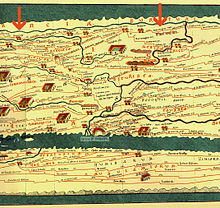
Back Dolnogermánský limes Czech Niedergermanischer Limes German הלימס של גרמאניה אינפריור HE ზემო გერმანიის ლიმესი Georgian Limes Germanicus inferior Latin Lejasģermānijas limes Latvian/Lettish Fruntieri Rumani Ġermaniċi t'Isfel Maltese Neder-Germaanse limes Dutch Romerrikets grenser – Nedre Germanias limes NB Niedergermanischer Limes Turkish
You can help expand this article with text translated from the corresponding article in Dutch. Click [show] for important translation instructions.
|
You can help expand this article with text translated from the corresponding article in German. Click [show] for important translation instructions.
|
| UNESCO World Heritage Site | |
|---|---|
 Map of the Lower Germanic Limes | |
| Location | Germany, Netherlands |
| Criteria | Cultural: (ii), (iii), (iv) |
| Reference | 1631 |
| Inscription | 2021 (44th Session) |

(between VLPIA NOVIOMAGVS BATAVORVM und RIGOMAGVS) on the Tabula Peutingeriana
The Lower Germanic Limes (Latin: limes ad Germaniam inferiorem, Dutch: Neder-Germaanse Limes, German: Niedergermanischer Limes) is the former frontier between the Roman province of Germania Inferior and Germania Magna. The Lower Germanic Limes separated that part of the Rhineland left of the Rhine as well as the southern part of the Netherlands, which was part of the Roman Empire, from the less tightly controlled regions east of the Rhine.
The route of the limes started near the estuary of the Oude Rijn on the North Sea. It then followed the course of the Rhine and ended at the Vinxtbach in present-day Niederbreisig, a quarter in the town of Bad Breisig, the border with the province of Germania Superior. The Upper Germanic-Rhaetian Limes then started on the opposite, right-hand, side of the Rhine with the Roman camp of Rheinbrohl.
The Lower Germanic Limes was not a fortified limes with ramparts, ditches, palisades or walls and watchtowers, but a river border (Lat.: ripa), similarly to the limites on the Danube and Euphrates. The Rhine Line was guarded by a chain of castra for auxiliary troops. It was laid out partly by Augustus and his stepson and military commander Drusus, who began to strengthen the natural boundary of the Rhine from the year 15 AD The decision not to conquer the regions east of the Rhine in 16 AD made the Rhine into a fixed frontier of the Roman Empire. For its protection, many estates (villae rusticae) and settlements (vici) were established. The names and locations of several sites have been handed down, mainly through the Tabula Peutingeriana and Itinerarium Antonini.[1]
Together with the Upper Germanic-Rhaetian Limes, the Lower Germanic Limes forms part of the Limes Germanicus. In 2021, the Lower Germanic Limes were inscribed on the UNESCO World Heritage List as part of the set of "Frontiers of the Roman Empire" World Heritage Sites.
- ^ Tilmann Bechert, Willem J. H. Willems: Die römische Reichsgrenze von der Mosel bis zur Nordseeküste. Stuttgart, 1995, ISBN 3-8062-1189-2; Margot Klee: Grenzen des Imperiums. Leben am römischen Limes. Konrad Theiss Verlag, Stuttgart, 2006, ISBN 3-8053-3429-X, pp. 33–40.